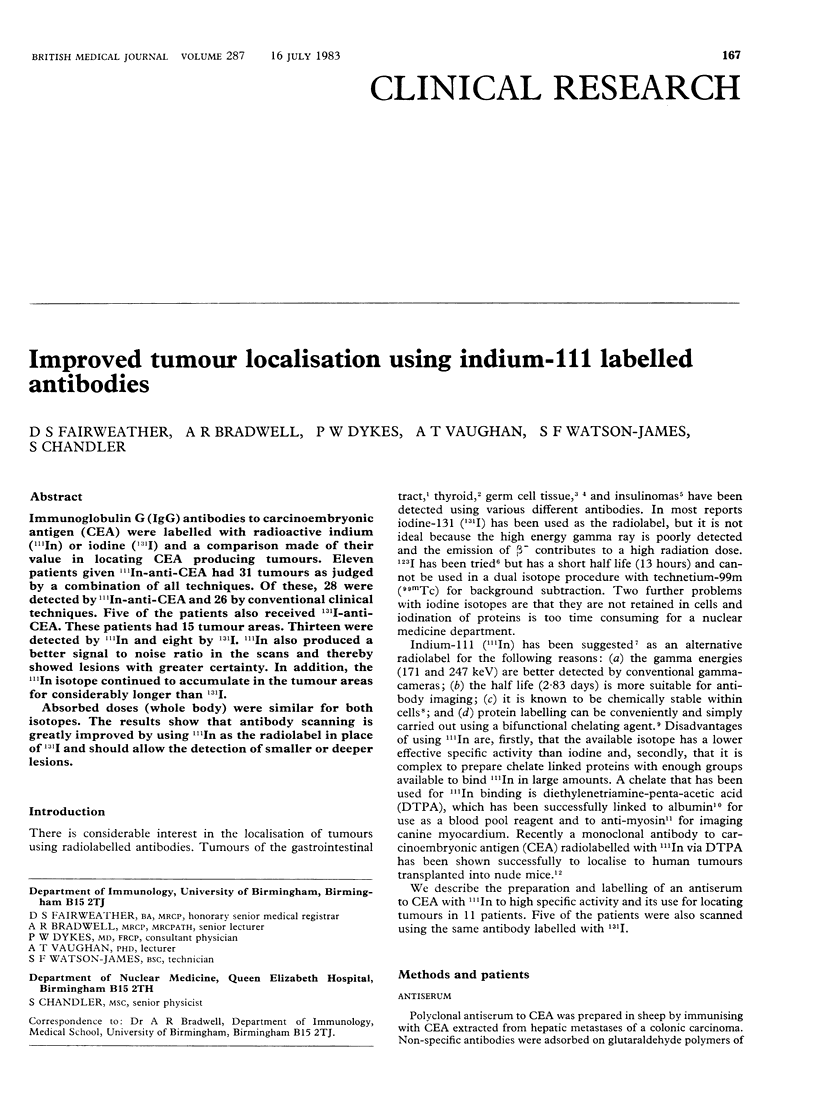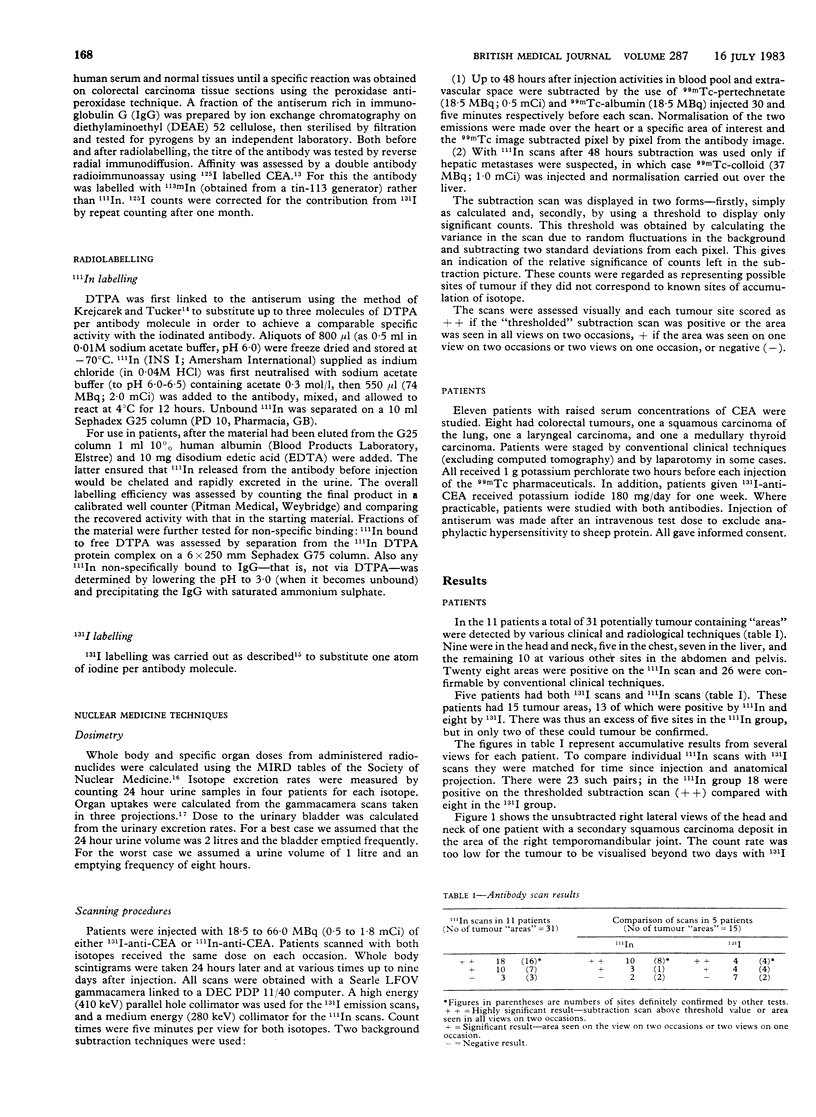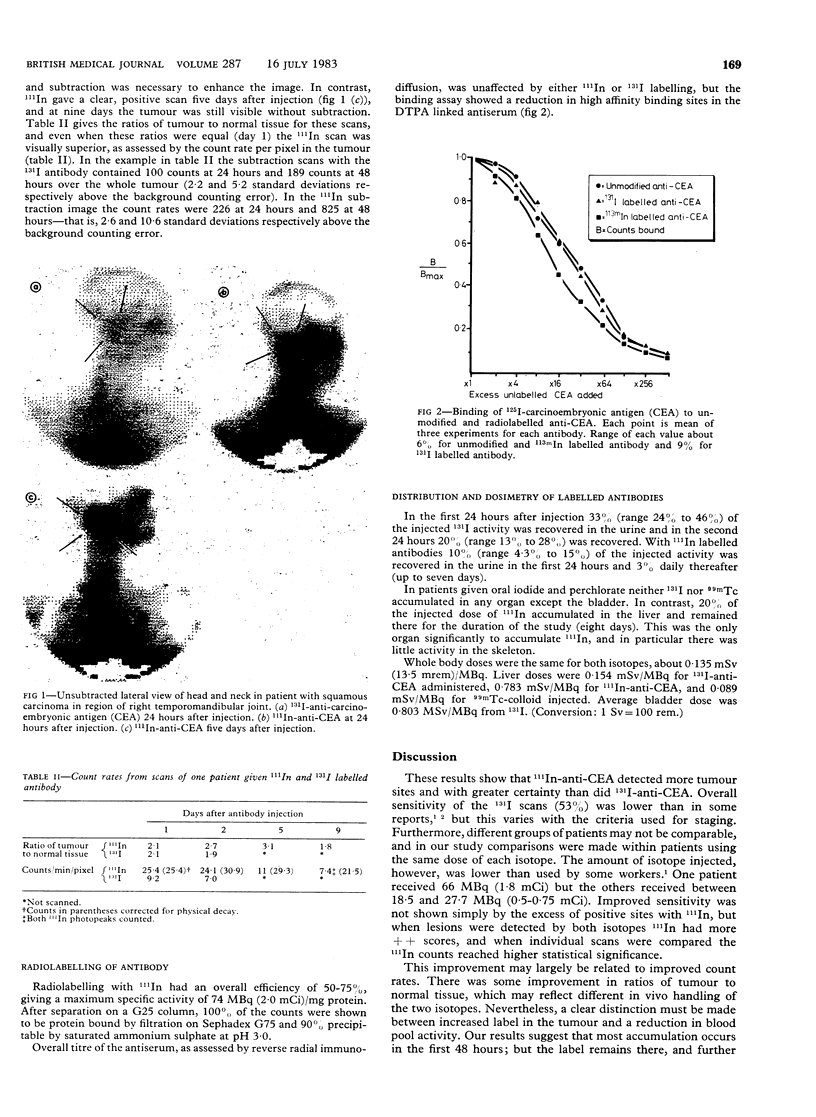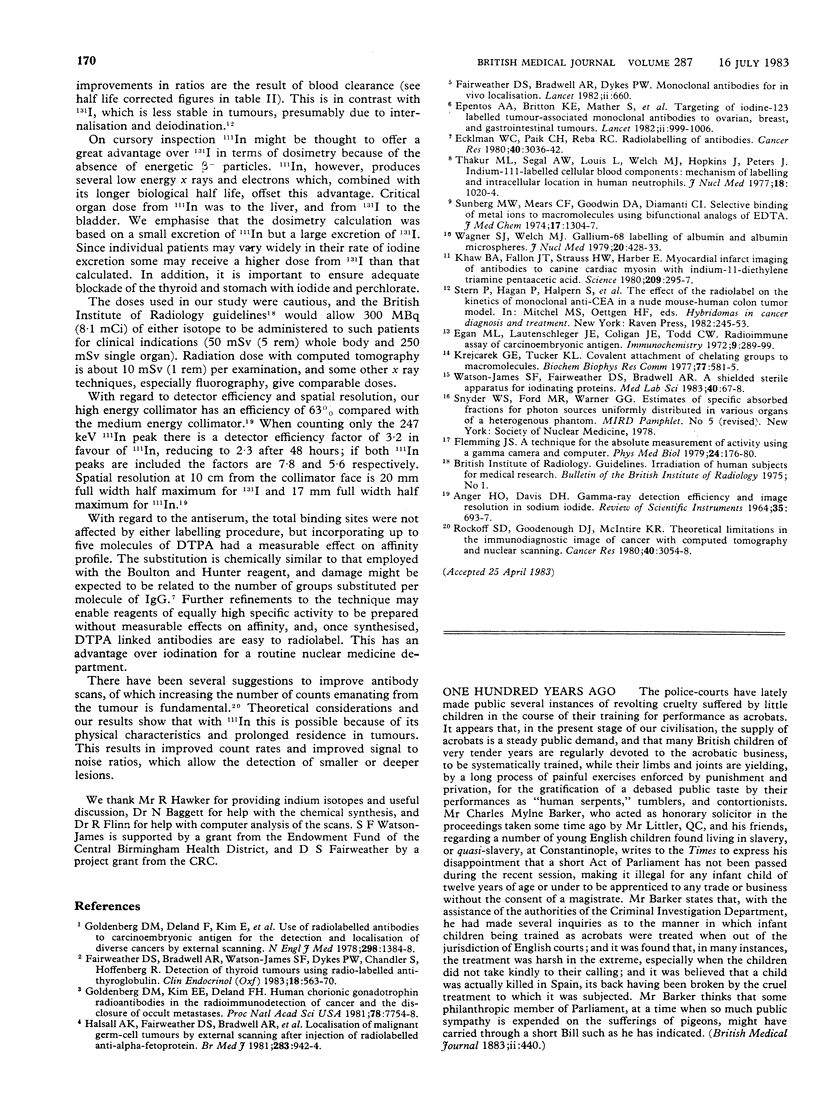Abstract
Immunoglobulin G (IgG) antibodies to carcinoembryonic antigen (CEA) were labelled with radioactive indium (111In) or iodine (131I) and a comparison made of their value in locating CEA producing tumours. Eleven patients given 111In-anti-CEA had 31 tumours as judged by a combination of all techniques. Of these, 28 were detected by 111In-anti-CEA and 26 by conventional clinical techniques. Five of the patients also received 131I-anti-CEA. These patients had 15 tumour areas. Thirteen were detected by 111In and eight by 131I. 111In also produced a better signal to noise ratio in the scans and thereby showed lesions with greater certainty. In addition, the 111In isotope continued to accumulate in the tumour areas for considerably longer than 131I. Absorbed doses (whole body) were similar for both isotopes. The results show that antibody scanning is greatly improved by using 111In as the radiolabel in place of 131I and should allow the detection of smaller or deeper lesions.
Full text
PDF



Selected References
These references are in PubMed. This may not be the complete list of references from this article.
- Eckelman W. C., Paik C. H., Reba R. C. Radiolabeling of antibodies. Cancer Res. 1980 Aug;40(8 Pt 2):3036–3042. [PubMed] [Google Scholar]
- Egan M. L., Lautenschleger J. T., Coligan J. E., Todd C. W. Radioimmune assay of carcinoembryonic antigen. Immunochemistry. 1972 Mar;9(3):289–299. doi: 10.1016/0019-2791(72)90093-6. [DOI] [PubMed] [Google Scholar]
- Epenetos A. A., Britton K. E., Mather S., Shepherd J., Granowska M., Taylor-Papadimitriou J., Nimmon C. C., Durbin H., Hawkins L. R., Malpas J. S. Targeting of iodine-123-labelled tumour-associated monoclonal antibodies to ovarian, breast, and gastrointestinal tumours. Lancet. 1982 Nov 6;2(8306):999–1005. doi: 10.1016/s0140-6736(82)90046-0. [DOI] [PubMed] [Google Scholar]
- Fairweather D. S., Bradwell A. R., Dykes P. W. Monoclonal antibodies for in-vivo localization. Lancet. 1982 Sep 18;2(8299):660–660. doi: 10.1016/s0140-6736(82)92760-x. [DOI] [PubMed] [Google Scholar]
- Fairweather D. S., Bradwell A. R., Watson-James S. F., Dykes P. W., Chandler S., Hoffenberg R. Detection of thyroid tumours using radio-labelled anti-thyroglobulin. Clin Endocrinol (Oxf) 1983 Jun;18(6):563–570. doi: 10.1111/j.1365-2265.1983.tb00594.x. [DOI] [PubMed] [Google Scholar]
- Fleming J. S. A technique for the absolute measurement of activity using a gamma camera and computer. Phys Med Biol. 1979 Jan;24(1):176–180. doi: 10.1088/0031-9155/24/1/017. [DOI] [PubMed] [Google Scholar]
- Goldenberg D. M., DeLand F., Kim E., Bennett S., Primus F. J., van Nagell J. R., Jr, Estes N., DeSimone P., Rayburn P. Use of radiolabeled antibodies to carcinoembryonic antigen for the detection and localization of diverse cancers by external photoscanning. N Engl J Med. 1978 Jun 22;298(25):1384–1386. doi: 10.1056/NEJM197806222982503. [DOI] [PubMed] [Google Scholar]
- Goldenberg D. M., Kim E. E., DeLand F. H. Human chorionic gonadotropin radioantibodies in the radioimmunodetection of cancer and for disclosure of occult metastases. Proc Natl Acad Sci U S A. 1981 Dec;78(12):7754–7758. doi: 10.1073/pnas.78.12.7754. [DOI] [PMC free article] [PubMed] [Google Scholar]
- Halsall A. K., Fairweather D. S., Bradwell A. R., Blackburn J. C., Dykes P. W., Howell A., Reeder A., Hine K. R. Localisation of malignant germ-cell tumours by external scanning after injection of radiolabelled anti-alpha-fetoprotein. Br Med J (Clin Res Ed) 1981 Oct 10;283(6297):942–944. doi: 10.1136/bmj.283.6297.942. [DOI] [PMC free article] [PubMed] [Google Scholar]
- James S. F., Fairweather D. S., Bradwell A. R. A shielded, sterile apparatus for iodinating proteins. Med Lab Sci. 1983 Jan;40(1):67–68. [PubMed] [Google Scholar]
- Khaw B. A., Fallon F. T., Strauss H. W., Haber E. Myocardial infarct imaging of antibodies to canine cardiac myosin with indium-111-diethylenetriamine pentaacetic acid. Science. 1980 Jul 11;209(4453):295–297. doi: 10.1126/science.7384803. [DOI] [PubMed] [Google Scholar]
- Krejcarek G. E., Tucker K. L. Covalent attachment of chelating groups to macromolecules. Biochem Biophys Res Commun. 1977 Jul 25;77(2):581–585. doi: 10.1016/s0006-291x(77)80018-1. [DOI] [PubMed] [Google Scholar]
- Rockoff S. D., Goodenough D. J., McIntire K. R. Theoretical limitations in the immunodiagnostic imaging of cancer with computed tomography and nuclear scanning. Cancer Res. 1980 Aug;40(8 Pt 2):3054–3058. [PubMed] [Google Scholar]
- Sundberg M. W., Meares C. F., Goodwin D. A., Diamanti C. I. Selective binding of metal ions to macromolecules using bifunctional analogs of EDTA. J Med Chem. 1974 Dec;17(12):1304–1307. doi: 10.1021/jm00258a015. [DOI] [PubMed] [Google Scholar]
- Wagner S. J., Welch M. J. Gallium-68 labeling of albumin and albumin microspheres. J Nucl Med. 1979 May;20(5):428–433. [PubMed] [Google Scholar]


